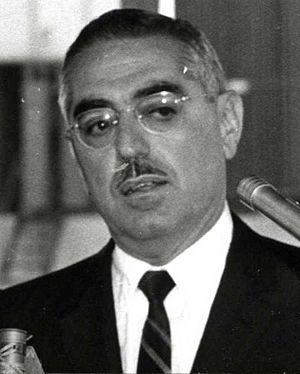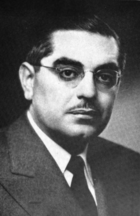John Pastore facts for kids
Quick facts for kids
John Pastore
|
|
|---|---|

Pastore in 1961
|
|
| United States Senator from Rhode Island |
|
| In office December 19, 1950 – December 28, 1976 |
|
| Preceded by | Edward L. Leahy |
| Succeeded by | John Chafee |
| 61st Governor of Rhode Island | |
| In office October 6, 1945 – December 19, 1950 |
|
| Lieutenant | vacant (1945-47) John S. McKiernan (1947-50) |
| Preceded by | J. Howard McGrath |
| Succeeded by | John S. McKiernan |
| 54th Lieutenant Governor of Rhode Island | |
| In office January 1945 – October 6, 1945 |
|
| Governor | J. Howard McGrath |
| Preceded by | Louis W. Cappelli |
| Succeeded by | John S. McKiernan |
| Member of the Rhode Island House of Representatives |
|
| In office 1934–1937 |
|
| Personal details | |
| Born |
John Orlando Pastore
March 17, 1907 Providence, Rhode Island, U.S. |
| Died | July 15, 2000 (aged 93) Cranston, Rhode Island, U.S. |
| Political party | Democratic |
| Spouse | Elena Caito |
| Children | 3 |
| Education | Northeastern University (LLB) |
John Orlando Pastore (March 17, 1907 – July 15, 2000) was an American lawyer and politician. He was a member of the Democratic Party. He served as a U.S. Senator for Rhode Island from 1950 to 1976. Before that, he was the 61st Governor of Rhode Island from 1945 to 1950. He was the first Italian American person ever elected to the U.S. Senate.
Contents
Early Life and Education
John Pastore was born in the Federal Hill area of Providence, Rhode Island. He was the second of five children. His parents, Michele and Erminia Pastore, were immigrants from Italy.
His father, a tailor, came to the United States in 1899. He died when John was nine years old. John's mother then worked as a seamstress to support the family. She later married her late husband's brother, Salvatore, who also had a tailoring business.
As a child, John worked many jobs. He delivered coats and suits for his uncle. He also ran errands for a law office. He even worked in a jewelry factory.
John graduated with honors from Classical High School in 1925. He then worked for a year as a claims adjuster. In 1927, he started studying law at Northeastern University. He earned his law degree in 1931. The next year, he became a lawyer. He opened a law office in his family's home. However, it was during the Great Depression, so he didn't have many clients.
Political Career
Serving Rhode Island
In 1934, John Pastore was elected to the Rhode Island House of Representatives. He was re-elected in 1936. He became the chairman of an important committee there. From 1937 to 1938, he worked as an assistant attorney general. He lost this job when the Republican Party won many elections.
From 1939 to 1940, he was part of a commission that updated Providence's city rules. When the Democratic Party regained power in 1940, Pastore was again appointed assistant attorney general. He worked on criminal cases until 1944. In July 1941, he married Elena Caito. They stayed married until his death and had three children.
Governor of Rhode Island
In 1944, Pastore was elected Lieutenant Governor of Rhode Island. On October 6, 1945, he became Governor of Rhode Island. This happened when Governor J. Howard McGrath resigned. McGrath left to become a top lawyer for President Harry S. Truman.
During his first year as governor, Pastore created a one-percent sales tax. In 1946, he was elected to a full term as governor. He won against his opponent, John G. Murphy. This made him the first Italian American person to be elected governor in the United States.
He was re-elected in 1948. During his time as governor, he made new laws. These included the state's first primary election law. He also created a corporate income tax. He started a program to clean up water pollution. He also gave a $20 million bonus to World War II veterans.
U.S. Senate
In 1950, Pastore was elected to the United States Senate. He won a special election to take over from J. Howard McGrath. McGrath had resigned to become the U.S. Attorney General. Pastore was re-elected four more times.
In 1964, Pastore gave a major speech at the Democratic National Convention. This event nominated Lyndon B. Johnson for president.
One of his most famous moments happened in 1969. He was the chairman of a Senate committee. They were discussing funding for PBS and the Corporation for Public Broadcasting. Former President Lyndon B. Johnson wanted $20 million for it. However, President Richard Nixon wanted to cut the funding to $10 million. This was because of the costs of the Vietnam War.
Fred Rogers, the host of Mister Rogers' Neighborhood, spoke to the committee. He argued for the full $20 million. In just six minutes, Rogers explained why public television was important. He talked about how it helped children learn about feelings. Senator Pastore was known for being tough. But he told Rogers that his words gave him "goose bumps." After Rogers sang a song from his show, Pastore said, "I think it's wonderful. Looks like you just earned the $20 million." The next year, PBS funding increased from $9 million to $22 million.
In 1976, Pastore decided not to run for re-election. He retired from the Senate.
Personal Life
John Pastore and his wife Elena had three children. They also had seven grandchildren. He lived in Cranston, Rhode Island until he passed away on July 15, 2000. He died due to kidney failure.
His speech at the 1964 Democratic National Convention was very famous. Senator Ted Kennedy said that his brother, John F. Kennedy, thought highly of Pastore.
University of Rhode Island's Pastore Hall is named after him. It was built in 1953.


